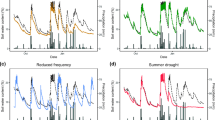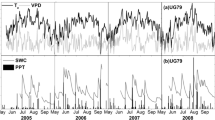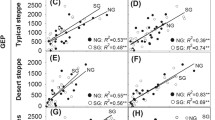Abstract
Background and aims
Temperate grasslands are a globally important component of agricultural production systems and a major contributor to the exchange of greenhouse gases (GHG) between the biosphere and atmosphere. Many intensively managed grazed grasslands in NW Europe are ploughed and reseeded occasionally in order to improve their productivity. Here, we examined the impact of ploughing on the emission of GHGs a grassland.
Methods
To study these interactions we measured soil GHG fluxes using the static chamber method in addition to the net ecosystem exchange (NEE) of CO2 by eddy covariance from two adjacent fields. Until ploughing one field in 2012 and the other in 2014, management of these intensively grazed grasslands was almost the same and typical for the study region.
Results
The effect on N2O is small, but distinguishable from the effects of N fertilisation, soil temperature and soil moisture. Tillage-induced N2O fluxes were close to expectations based on the IPCC default methodology. By far the dominant effect on the GHG balance was the temporary reduction in GPP.
Conclusions
Ploughing and reseeding can substantially influence short-term GHG emissions. Therefore tillage-induced fluxes ought to be considered when estimating greenhouse gas fluxes or budgets from grasslands that are periodically ploughed.






Similar content being viewed by others
References
Ball BC (2013) Soil structure and greenhouse gas emissions: a synthesis of 20 years of experimentation. Eur J Soil Sci 64:357–373
Ball BC, Horgan GW, Clayton H, Parker JP (1997) Spatial variability of nitrous oxide fluxes and controlling soil and topographic properties. J Environ Qual 26:1399–1409
Ball BC, Scott A, Parker JP (1999) Field N2O, CO2 and CH4 fluxes in relation to tillage, compaction and soil quality in Scotland. Soil Tillage Res 53:29–39
Ball BC, Griffiths BS, Topp CFE, Wheatley R, Walker RL, Rees RM, Watson CA, Gordon H, Hallett PD, McKenzie BM, Nevison IM (2014) Seasonal nitrous oxide emissions from field soils under reduced tillage, compost application or organic farming. Agriculture, Ecosystems & Environment 189:171–180
Brady NC, Weil RR (2002) The nature and properties of soils. Prentice Hall, New Jersey
Campbell BD, Stafford Smith DM (2000) A synthesis of recent global change research on pasture and rangeland production: reduced uncertainties and their management implications. Agriculture, Ecosystems & Environment 82:39–55
Clayton H, Arah JRM, Smith KA (1994) Measurement of nitrous oxide emissions from fertilized grassland using closed chambers. Journal of Geophysical Research: Atmospheres 99:16599–16607
Davies M, Smith K, Vinten A (2001) The mineralisation and fate of nitrogen following ploughing of grass and grass-clover swards. Biol Fertil Soils 33:423–434
De Klein C, Novoa R, Ogle S, Smith K, Rochette P, Wirth T, McConkey B, Mosier A and Rypdal K (2006) N2O Emissions from Managed Soils, and CO2 Emissions from Lime and Urea Application. In Volume 4 Agriculture, Forestry and Other Land Use, vol. 4. IPCC Guidelines for National Greenhouse Gas Inventories. Intergovernmental Panel on Climate Change, Geneva
EEA 2005 The European Environment. State and Outlook 2005. Ed. E E Agency., Copenhagen.
Eriksen J, Jensen LS (2001) Soil respiration, nitrogen mineralization and uptake in barley following cultivation of grazed grasslands. Biol Fertil Soils 33:139–145
Estavillo JM, Merino P, Pinto M, Yamulki S, Gebauer G, Sapek A, Corré W (2002) Short term effect of ploughing a permanent pasture on N2O production from nitrification and denitrification. Plant Soil 239:253–265
Helfter C, Campbell C, Dinsmore KJ, Drewer J, Coyle M, Anderson M, Skiba U, Nemitz E, Billett MF, Sutton MA (2015) Drivers of long-term variability in CO2 net ecosystem exchange in a temperate peatland. Biogeosciences 12:1799–1811
IPCC (2014) Summary for Policymakers. In Mitigation of Climate Change. Contribution of Working Group III to the Fifth Assessment Report of the Intergovernmental Panel on Climate Change., Cambridge.
Jones SK, Rees RM, Skiba UM, Ball BC (2005) Greenhouse gas emissions from a managed grassland. Glob Planet Chang 47:201–211
Jones S, Helfter C, Anderson M, Coyle M, Campbell C, Famulari D, Di Marco C, van Dijk N, Topp K, Kiese R, Kindler R, Siemens J, Schrumpf M, Kaiser K, Nemitz E, Levy P, Rees R, Sutton M, and Skiba U 2016 The nitrogen, carbon and greenhouse gas budget of a grazed, cut and fertilised temperate grassland, Biogeosciences Discussions, bg-2016, submitted
Karlen DL, Kovar JL, Cambardella CA, Colvin TS (2013) Thirty-year tillage effects on crop yield and soil fertility indicators. Soil & Tillage Research 130:24–41
Kessavalou A, Mosier AR, Doran JW, Drijber RA, Lyon DJ, Heinemeyer O (1998) Fluxes of carbon dioxide, nitrous oxide, and methane in grass sod and winter wheat-fallow tillage management. J Environ Qual 27:1094–1104
Kormann R, Meixner FX (2001) An analytical footprint model for non-neutral stratification. Bound-Layer Meteorol 99:207–224
Lehtinen T, Schlatter N, Baumgarten A, Bechini L, Krüger J, Grignani C, Zavattaro L, Costamagna C, Spiegel H (2014) Effect of crop residue incorporation on soil organic carbon and greenhouse gas emissions in European agricultural soils. Soil Use Manag 30:524–538
Levy PE, Burden A, Cooper MDA, Dinsmore KJ, Drewer J, Evans C, Fowler D, Gaiawyn J, Gray A, Jones SK, Jones T, McNamara NP, Mills R, Ostle N, Sheppard LJ, Skiba U, Sowerby A, Ward SE, Zielinski P (2012) Methane emissions from soils: synthesis and analysis of a large UK data set. Glob Chang Biol 18:1657–1669
MacDonald JD, Rochette P, Chantigny MH, Angers DA, Royer I, Gasser M-O (2011) Ploughing a poorly drained grassland reduced N2O emissions compared to chemical fallow. Soil Tillage Res 111:123–132
Merbold L, Eugster W, Stieger J, Zahniser M, Nelson D, Buchmann N (2014) Greenhouse gas budget (CO2, CH4 and N2O) of intensively managed grassland following restoration. Glob Chang Biol 20:1913–1928
Omonode RA, Vyn TJ, Smith DR, Hegymegi P, Gál A (2007) Soil carbon dioxide and methane fluxes from long-term tillage systems in continuous corn and corn–soybean rotations. Soil Tillage Res 95:182–195
Pagliai M, Vignozzi N, Pellegrini S (2004) Soil structure and the effect of management practices. Soil & Tillage Research 79:131–143
Pinheiro JC, Bates DM (2004) Mixed-effects models in S and S-PLUS. Springer, New York
Reicosky DC (1997) Tillage-induced CO2 emission from soil. Nutr Cycl Agroecosyst 49:273–285
Six J, Elliott ET, Paustian K (2000) Soil macroaggregate turnover and microaggregate formation: a mechanism for C sequestration under no-tillage agriculture. Soil Biology and Biochemistry 32:2099–2103
Skiba U, Jones SK, Dragosits U, Drewer J, Fowler D, Rees RM, Pappa VA, Cardenas L, Chadwick D, Yamulki S, Manning AJ (2012) UK emissions of the greenhouse gas nitrous oxide. Philosophical transactions of the royal society. B-Biological Sciences 367:1175–1185
Skiba U, Jones SK, Drewer J, Helfter C, Anderson M, Dinsmore K, McKenzie R, Nemitz E, Sutton MA (2013) Comparison of soil greenhouse gas fluxes from extensive and intensive grazing in a temperate maritime climate. Biogeosciences 10:1231–1241
Soane BD, Ball BC, Arvidsson J, Basch G, Moreno F, Roger-Estrade J (2012) No-till in northern, western and South-Western Europe: a review of problems and opportunities for crop production and the environment. Soil Tillage Res 118:66–87
Soussana JF, Allard V, Pilegaard K, Ambus P, Amman C, Campbell C, Ceschia E, Clifton-Brown J, Czobel S, Domingues R, Flechard C, Fuhrer J, Hensen A, Horvath L, Jones M, Kasper G, Martin C, Nagy Z, Neftel A, Raschi A, Baronti S, Rees RM, Skiba U, Stefani P, Manca G, Sutton M, Tuba Z, Valentini R (2007) Full accounting of the greenhouse gas (CO2, N2O, CH4) budget of nine European grassland sites. Agriculture, Ecosystems & Environment 121:121–134
Uchida Y, Clough TJ, Kelliher FM, Sherlock RR (2008) Effects of aggregate size, soil compaction, and bovine urine on N2O emissions from a pasture soil. Soil Biol Biochem 40:924–931
Velthof GL, Hoving IE, Dolfing J, Smit A, Kuikman PJ, Oenema O (2010) Method and timing of grassland renovation affects herbage yield, nitrate leaching, and nitrous oxide emission in intensively managed grasslands. Nutr Cycl Agroecosyst 86:401–412
Vinten AJA, Ball BC, O'Sullivan MF, HenshallL JK (2002) The effects of cultivation method, fertilizer input and previous sward type on organic C and N storage and gaseous losses under spring and winter barley following long-term leys. J Agric Sci 139:231–243
Willems AB, Augustenborg CA, et al. (2011) Carbon dioxide emissions from spring ploughing of grassland in Ireland. Agriculture Ecosystems & Environment 144(1):347–351
Yamulki S, Jarvis S (2002) Short-term effects of tillage and compaction on nitrous oxide, nitric oxide, nitrogen dioxide, methane and carbon dioxide fluxes from grassland. Biol Fertil Soils 36:224–231
Acknowledgments
The authors would like to thank Wim Bosma, farm manager for the Easter Bush field site, for site access. We are grateful to Nick Cowan, Helen Gordon, Zhaowei Gu, Wei An and Angela Tellez-Rio for assistance with field work. We also thank DEFRA and the Scottish Government for financial support through the UK GHG Platform project AC0116 (The InveN2Ory project).
Author information
Authors and Affiliations
Corresponding author
Additional information
Responsible Editor: Klaus Butterbach-Bahl.
Rights and permissions
About this article
Cite this article
Drewer, J., Anderson, M., Levy, P. et al. The impact of ploughing intensively managed temperate grasslands on N2O, CH4 and CO2 fluxes. Plant Soil 411, 193–208 (2017). https://doi.org/10.1007/s11104-016-3023-x
Received:
Accepted:
Published:
Issue Date:
DOI: https://doi.org/10.1007/s11104-016-3023-x




